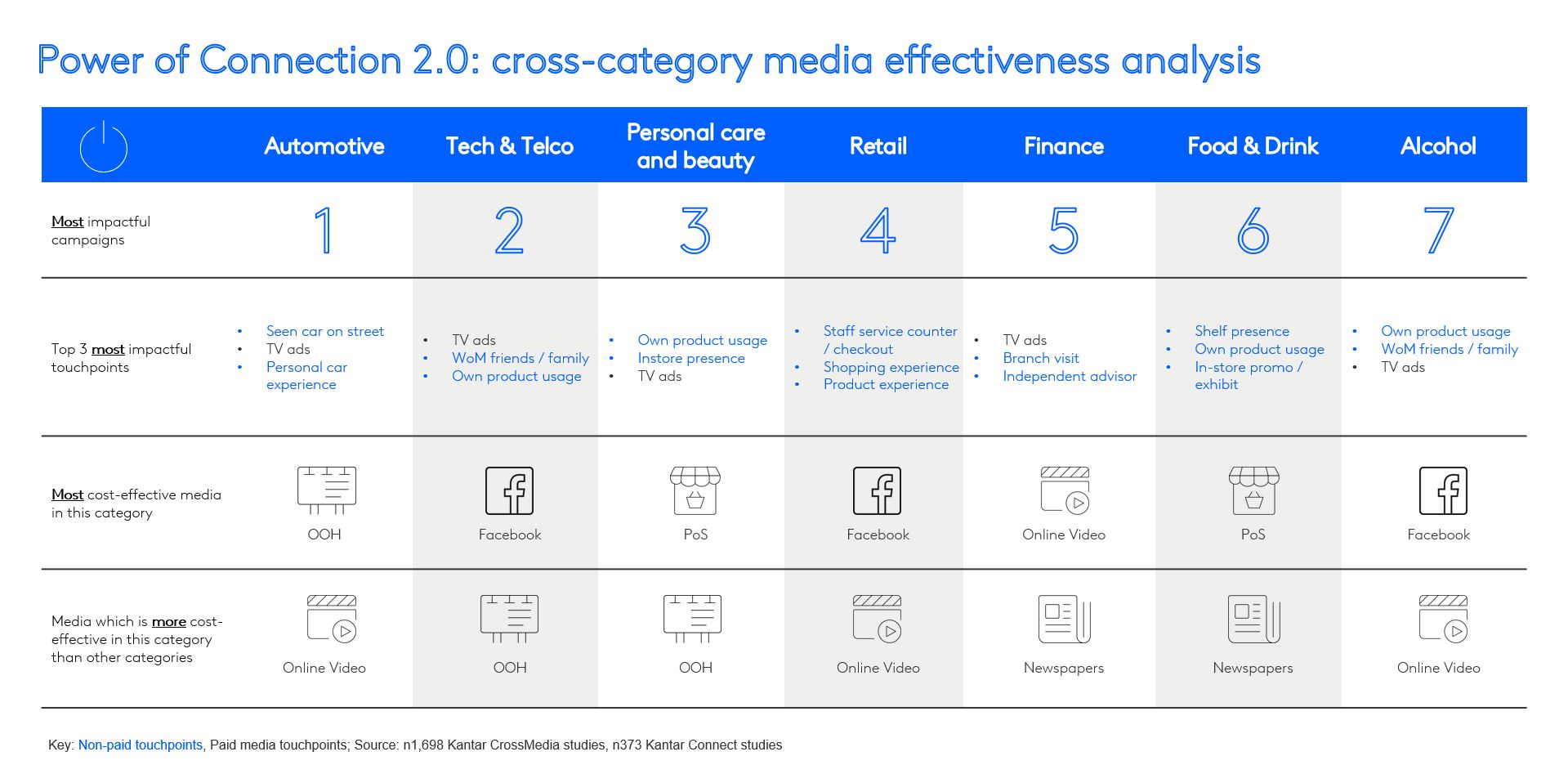During 2020 Kantar has published seven category-specific media effectiveness investigations covering food and drink, tech and telco, alcohol, finance, personal care and beauty, automotive and retail. Through this process we’ve discovered that each of these category doors has its own media effectiveness keys, but there are also a few master keys that unlock impact and effectiveness across all categories.
One size doesn’t fit all
The 20:80 rule based on findings from the Kantar Connect database says that 20% of touchpoints typically create 80% of total brand impact. Less is generally more; however, the most impactful touchpoints differ significantly according to the category. For instance, TV is among the top three most influential touchpoints for most categories but is less important for retail brands. Print advertising is among the most impactful touchpoints for food and drink, finance, and personal care and beauty, but isn’t as important for other categories. This means there isn’t a one-size-fits-all solution when it comes to the perfect touchpoint mix and each brand needs to identify what works best for its category and country, as well as its own positioning and competitive situation.
Another key learning point is that around 75% of total brand impact comes from non-paid touchpoints (including product experience and word of mouth) across all categories. Interestingly, tech and telco, retail and automotive tend to get slightly more contribution from paid media, while FMCG categories (personal care, alcohol and food and drink) seem to benefit more from non-paid media. This isn’t too surprising because product experience becomes even more “personal” when we’re eating, drinking or dealing with personal care.
Kantar’s CrossMedia solution reveals that the most powerful overall paid media efforts are observed in the automotive, tech and telco, and personal care and beauty categories. In part, this is due to these categories generating a higher share of contribution due to synergistic effects across media. Generally, 77% of paid touchpoint impact comes from offline media, yet retail and automotive brands rely less on offline media, while food and drink relies on it more.
There is further variation across categories when we look at how cost-effectively brands manage to deploy certain media. Some categories manage to turn less cost-effective touchpoints into more profitable ones (like online display in the alcohol category or OOH for tech and telco brands). Also, some touchpoints do not build brands as well as they do for all categories (like online video for food and drink brands and newspapers for tech and telco brands).
Some of the major variations in cross-category impact are summarised in the table below.
The master keys
Despite this variation in the impact and performance of media across categories, there are three recurring themes which operate as master keys.
- Brands should not rely too heavily on any one type of media
Although too many touchpoints can cause inefficiency, the same is also true when too few are deployed. Variety in the media mix, along with high levels of integration, increases the chances of synergistic effects, which will result in more impactful campaigns. A Nivea Cellular Anti-Age campaign in Australia showed that more synergistic effects can lead to a higher ROI. Nivea used Kantar’s CrossMedia solution to evaluate how integrated messaging and key visuals worked across point of sale, TV, magazines, and social media. We learned that while TV built awareness, it was the multimedia effects across TV, magazines, point of sale, and Facebook that drove image associations and purchase intent. The synergistic approach resulted in the highest ROI of all Nivea campaigns measured.
- The power of word of mouth and recommendations from friends and family based on positive product experiences
These are among the most impactful touchpoints for many categories. Brands should create more personal relationships with users by blending innovative and digitalised physical experiences with more human and friendly digital experiences. This online versus offline dilemma doesn't need to be a trade-off. Both can happen when sales staff in stores can better answer your question because they can instantly check stock via an app, or when an online store has a chatbot that actually works, or hands you off quickly to a real person if it doesn’t.
- Across all the investigated categories, the rapidly evolving digital environment implies an inevitable acceleration of the consumer journey
The boundaries between traditional phases of awareness, image associations and purchase intent, up to the conversion itself are getting more and more blurred by new digital formats such as shopvertising, social commerce or livestream e-commerce to name just a few. This cannot be ignored as digital now accounts for more than 50% of the media spend worldwide according to GroupM and is still rising fast.
This comprehensive new learning point provides helpful general insights to help unlock media effectiveness doors. However, we need to remember that nothing is written in stone in media and the current media landscape is especially volatile which means that brands need to constantly review the most relevant channels of communication, and test what works best for them.
To learn more by downloading your copy of the full cross-category touchpoint analysis, please complete the form found here.


